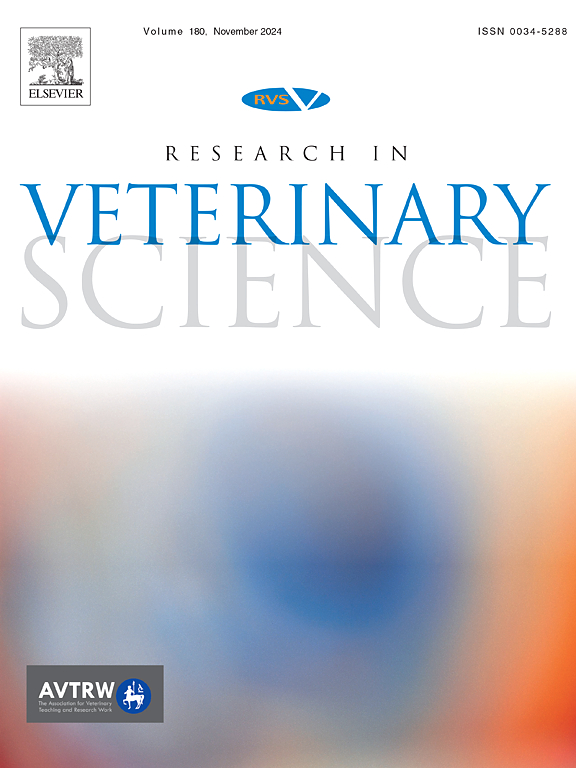Survey on canine hookworms: Knowledge, perceptions and practices among U.S. veterinarians
IF 2.2
3区 农林科学
Q1 VETERINARY SCIENCES
引用次数: 0
Abstract
Canine hookworms (Ancylostoma caninum) are highly prevalent in pet dogs in the United States of America (U.S.). They pose a significant health risk to infected dogs and are also a potential risk to humans as zoonotic agents. Veterinarians play a crucial role in managing this threat through the diagnosis and treatment of infections in pet dogs. However, the rising incidence of anthelmintic resistance in U.S. hookworm populations necessitates increased awareness among veterinarians. To determine U.S. veterinarian's knowledge, perceptions and practices about canine hookworms, a cross-sectional online survey was administered between February and December 2022. 208 veterinarians from 43 states participated in the study. Only 65 % of veterinarians reported awareness of hookworm prevalence. Hookworm infected dogs were encountered more frequently in the South than in Western states. Veterinarians perceived that hookworms were present in all breeds without breed predilection followed by mixed breeds, pit bulls and hound breeds. Most respondents reported that infections were rarely symptomatic, highlighting the importance of diagnostic testing. In-clinic diagnostic modalities were most preferred. Fenbendazole and pyrantel pamoate were the most commonly used anthelmintics. Most veterinarians followed up on infected dogs but retesting time after treatment varied. Awareness of multi-drug resistant hookworms was high but encountering persistent hookworm cases was lower. Veterinarians frequently educated clients about hookworms and prevention, but less about the zoonotic potential. This study provides insights for improving awareness, diagnostics, treatment protocols, and client education regarding canine hookworms in the U.S.. Overall, veterinarians play an active role in hookworm prevention and control.
犬钩虫调查:美国兽医的知识、观念和实践。
犬钩虫(Ancylostoma caninum)在美国的宠物狗中非常普遍。它们对受感染的狗构成重大健康风险,也作为人畜共患病病原体对人类构成潜在风险。兽医通过诊断和治疗宠物狗的感染,在管理这一威胁方面发挥着至关重要的作用。然而,在美国钩虫种群中,越来越多的抗虫率需要提高兽医的意识。为了确定美国兽医对犬钩虫的知识、认知和做法,在2022年2月至12月期间进行了一项横断面在线调查。来自43个州的208名兽医参与了这项研究。只有65%的兽医报告了解钩虫的流行。受钩虫感染的狗在南方比在西部各州更常见。兽医认为钩虫存在于所有品种中,没有品种偏好,其次是混合品种,比特犬和猎犬品种。大多数答复者报告说,感染很少有症状,这突出了诊断检测的重要性。临床诊断方式是首选。芬苯达唑和吡喃酯是最常用的驱虫药。大多数兽医对受感染的狗进行了随访,但治疗后重新检测的时间各不相同。对多重耐药钩虫的认识较高,但遇到持续性钩虫的病例较少。兽医经常教育客户关于钩虫和预防,但很少关于人畜共患的可能性。本研究为提高美国犬钩虫的认识、诊断、治疗方案和客户教育提供了见解。总之,兽医在钩虫的预防和控制中发挥着积极的作用。
本文章由计算机程序翻译,如有差异,请以英文原文为准。
求助全文
约1分钟内获得全文
求助全文
来源期刊

Research in veterinary science
农林科学-兽医学
CiteScore
4.40
自引率
4.20%
发文量
312
审稿时长
75 days
期刊介绍:
Research in Veterinary Science is an International multi-disciplinary journal publishing original articles, reviews and short communications of a high scientific and ethical standard in all aspects of veterinary and biomedical research.
The primary aim of the journal is to inform veterinary and biomedical scientists of significant advances in veterinary and related research through prompt publication and dissemination. Secondly, the journal aims to provide a general multi-disciplinary forum for discussion and debate of news and issues concerning veterinary science. Thirdly, to promote the dissemination of knowledge to a broader range of professions, globally.
High quality papers on all species of animals are considered, particularly those considered to be of high scientific importance and originality, and with interdisciplinary interest. The journal encourages papers providing results that have clear implications for understanding disease pathogenesis and for the development of control measures or treatments, as well as those dealing with a comparative biomedical approach, which represents a substantial improvement to animal and human health.
Studies without a robust scientific hypothesis or that are preliminary, or of weak originality, as well as negative results, are not appropriate for the journal. Furthermore, observational approaches, case studies or field reports lacking an advancement in general knowledge do not fall within the scope of the journal.
 求助内容:
求助内容: 应助结果提醒方式:
应助结果提醒方式:


